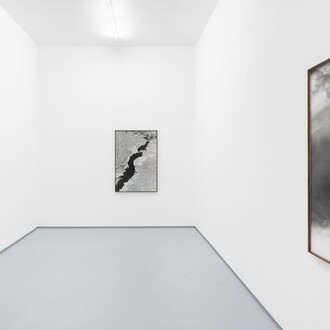Inspired by Virginia Woolf’s short text The death of the moth, the title of this exhibition, Wandering Moths, extends artist Belén Uriel’s long-standing concerns: the tension between manufactured objects of leisure and the bodies they are made for; the use of glass and metal to shape nearly organic forms; and the discreet poetry that emerges from the sphere of the functional.
Woolf’s text, a small moth beats against a windowpane, caught between the sheltered interior where the author writes and the expanse of the autumnal pastoral landscape outside, pregnant with energy — ploughmen and horses at work in the fields; a flock of rooks flying in unison in the skies. Although seemingly trivial in comparison, the moth’s struggle captures the author’s full attention and unfolds into a reflection on the inevitability of death and the fragile yet insistent vitality of life.
Akin to these themes, there is something existential about Uriel’s body of work, pertaining at once to the realm of death, to the feeling of being caught in a glass prison, and to the idea of watching the infinite possibilities of life from that limited vantage point. Hinting at nature and life- force, the uprightness of the sculptures shown in the gallery, as solemn steles or rising signs, as well as the relative solidity of the materials they are made from — aluminium, copper, iron, glass, and steel — bestow on these somber silhouettes a sense of strength and ascent. However, at the same time, their apparent rigidity is offset by the flickers of life these pieces tease us with from within. Some are reminiscent of organic forms or skeletons, as in Shell (fittings), for which, incidentally, Uriel turned off-the-rack backpacks inside out and used their internal frameworks as casts. Others, such as Insecta, resemble a moth or butterfly and present what look like modular articulations or exoskeletons — heavy, precious, yet fragile.
Uriel is known for working with mass-produced objects designed to support and protect the body outdoors: backpacks, helmets, sleeping bags, all unremarkable in their designs, unassuming and made solely for functionality. She transforms them — a gesture that has become part of her artistic lexicon — to give them a measure of soul through manipulations of form, as if the bodies they were made for had imprinted themselves onto them in return. Uriel’s vocabulary, however, extends beyond form. It operates through a series of subtle oppositions — between the mass- produced and the singular, the protective and the vulnerable, the cold inertness of metal and glass, and the warmth of lived experience.
As such, the idea of temperature becomes one of the ways these tensions surface, not only as a physical property but as a concept of proximity, contact, and exchanged energy. As cool and somehow inhospitable as the sculptures’ surfaces appear, they are counterbalanced by the ideas they carry: comfort, living impulse, organic forms. In Back, for instance — the melted imprint of something that might once have hugged the curve of a human spine — echoes the holding and giving off heat in its melted-looking form. This sensitivity to material thresholds is also evident in the artist’s casting process. In Janela, for instance, what might resemble insect legs appears either trapped between two panels — recalling the moth caught on Woolf’s windowpane — or creeping from beneath them. For this work, and for the standing sculptures at the centre of the space, Uriel created casts from four different types of insulation panels. Her practice often involves probing variations within standardized products, exploiting the generic quality of consumer goods; yet, on the other hand, she lends them a new vitality through the sculptural operations she performs on them. The result is an uneasy tension between the banal and the poetic, where what is nearly invisible or insignificant becomes charged with an almost alchemical role — capable of transporting us to a different realm, journeying from neutrality to a kind of sanctification.
Drawing from materials central to Uriel’s practice and the themes she favours, the exhibition bridges the realm of leisure and the outdoors with the need for protection from its risks — including the risk of losing breath or life — honouring our bodies, and those of the small beings around us, for wanting to wander and explore life’s possibilities yet struggling in the process. In this series, the works seem surrounded by an aura reminiscent of amulets or funerary shells — forms of protection that also confine, carapaces that shelter even as they impede. These ambivalences echo the deeper uncanny dualities of Uriel’s practice: an attraction to objects that mediate between life and death, recreation and existentialism, the singular detail and the ordinary commonalities. What emerges is a sculptural language in which the nearly invisible leads us to consider our rituals, survival strategies and the symbolism we attach to them. Where a little moth — who cares — can throw us off and prompt us to ask the most fundamental questions about the very means of our existence.
(Text by Cristina Sanchez-Kozyreva)
















